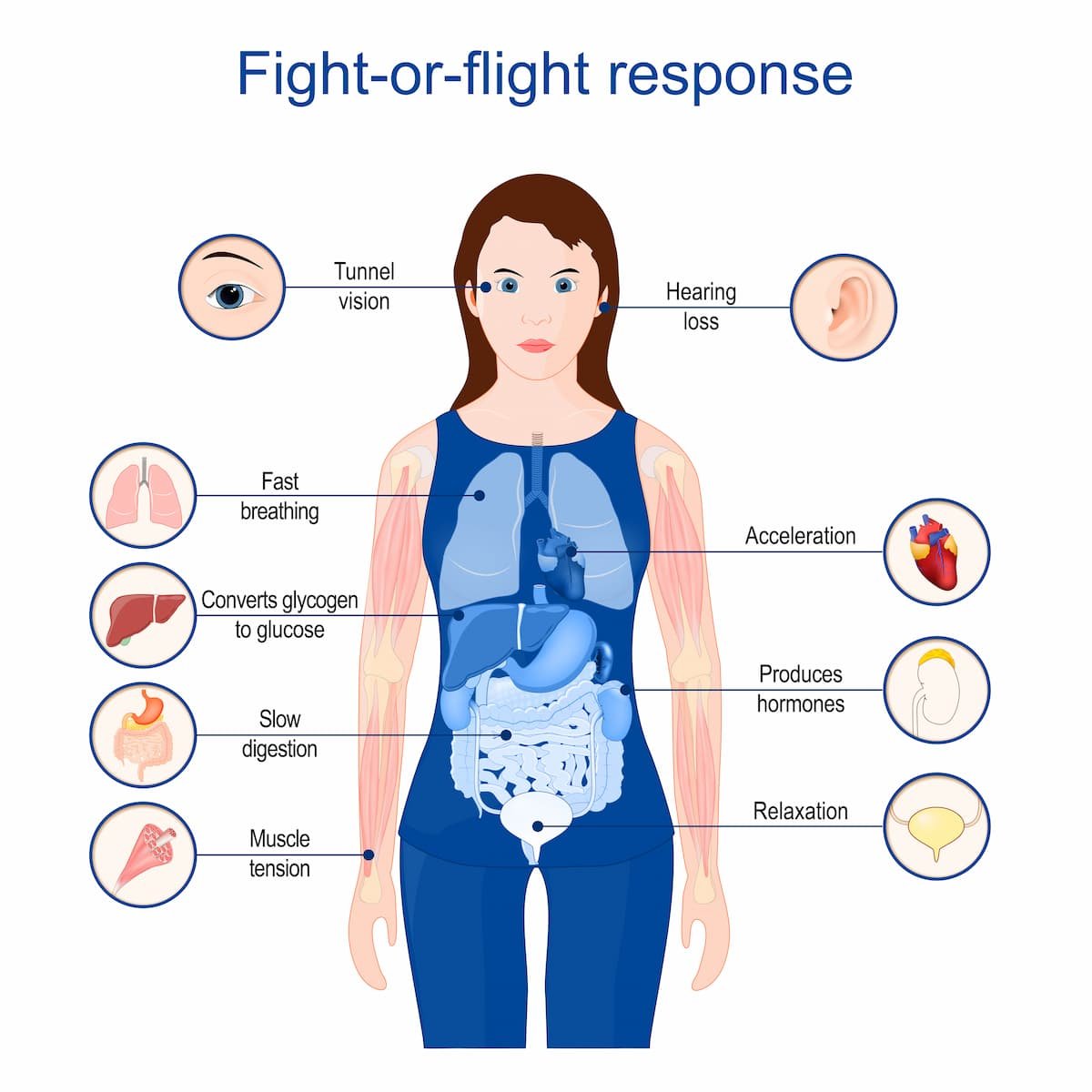The Stress Response
This depiction of the body’s responses in Fight or Flight is fairly common. Many of us are familiar with the physiological changes that happen reflexively when we are threatened. This image happens to show only the active stages of the stress response, however. Missing are the passive stages of the Sympathetic Nervous System that also occur reflexively but are not as well-known or understood. Also absent from most information about the stress response are the structural changes. Every mammal tucks their tail, ducks their head, shifts forwards on their toes, narrows their vision, and more. If we contemplate just one of the physiological changes mentioned in the infograph, we begin to realize how all of our bodily systems are involved in responding to a threat. Take tunnel vision, for instance. How does our body create this enhanced focus? Not only do our pupils dilate; the eye sockets change their orientation. Each eye orbit is made up of six bones, and all those cranial bones change their position so that we can focus on the threat at hand. Think about that huge structural shift that happens automatically, and how many different tissue types are involved to create the movement. Amazingly, our body reorganizes our structure and nerve supply so that we are not distracted by stimuli that would interfere with our surviving. As the bones shift, the trigeminal nerve (which is the main sensory nerve of the face), retracts into the skull, thereby lessening the receiving and transmitting of possibly painful messages. If we don’t feel the discomfort of a blow or bite to the face, we can defend ourselves successfully and get to safety.
Trigeminal Nerve. Our bones reposition and compress it in the stress response so that we aren’t distracted by sensory input that might hinder our ability to defend ourselves or get to safety.
Performing eye exercises, relaxation techniques or manual therapy to relieve tension in the eyes may have some benefits, but these practices do not generally allow all the cranial bones to move to a Parasympathetic position, which in turn, decompresses the trigeminal nerve so it can begin transmitting impulses again. For lasting change, our nervous system needs the information of where our structure is located in our current environment so it knows it can let go of the Fight or Flight reflexes. If we then do simple functional movement with the new positional awareness, we create and stabilize the new motor patterns. Just as our bodily reflexes narrowed our eye sockets, our body will let go of those reflexes and the sockets will begin returning to their original 45 degree angle on their own. We don’t actually need to try to get our eyes to change.
Try this Fajardo Method™ technique to allow your nervous system to reorganize your structure towards a Parasympathetic position. Take a look at my skull model and notice how the eye orbits are oriented.
Can you see how the inner eye orbits of each eye along the nose are almost parallel with each other? Notice how the outer eye orbits are at 45 degree angles. Now notice your own right inner eye orbit going straight and the right outer orbit. Is the outer orbit angled laterally? Is the inner orbit more forward to the front of your face than the outer orbit? You may get more information by touching the inner corner of your right eye with your left index finger, and the outer corner of your right eye with your right index finger. Notice their position Which one is more forward? Nonchalantly observe those Two Points of the right orbit for about 60 seconds and see what happens. Feel free to look away from the screen as you do this. Hanging out in the general area of the two locations (the two angles of the inner and outer orbit) is good enough, even if you aren’t sure of the exact place. There is no need to be able to label what is happening. Just stay with the structures as you observe any shifts. After 60 seconds, do you notice any differences between the right and left sides? Perhaps you can see further behind you on the right. Maybe the right eye orbit is further from your nose and more diagonal than the left. Maybe you notice changes in other structures such as your jaw or shoulder? Take a moment to scan your right and left sides. Now repeat this process with the left orbit for 60 seconds. Register any changes you notice, even if you can’t identify what they are. See what happens if you observe both eye orbits at the same time. Would they angle outward on the diagonal? It’s ok if the right and left orbits are different. Simply observe.
I am guessing you started to notice some shifts structurally and maybe even physiologically. Those changes were your body letting go of Fight or Flight reflexes and moving you towards your Parasympathetic Nervous System. If you found this interesting and want to engage in more exploration, I would suggest you have some guidance. You can contact me for a session or head over to FMHB™ for more information.



